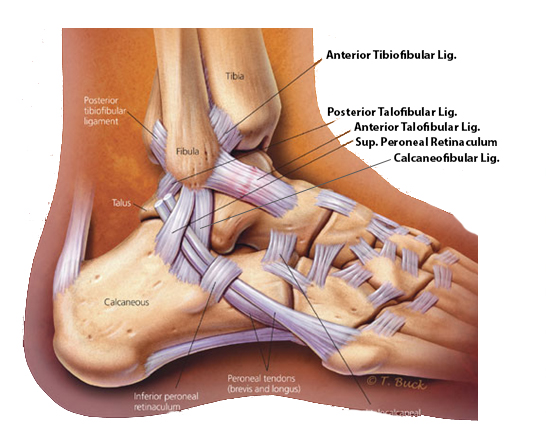Ankle Ligament Injuries
The ankle is made up of many connective tissues that connect the bones in the area. Although these connective tissues are flexible, they can be damaged as a result of trauma. The most common ankle ligament injuries are ankle sprains. This damage, which is frequently seen especially in athletes, usually resolves spontaneously and does not require surgical treatment. However, it is very important for the patient to be conscious in this process and to take the right steps.
What is Ankle Sprain?
An ankle sprain is one of the most common ligament injuries. It usually occurs as a result of damage to the anterior part of the external lateral ligaments. ankle joint; It consists of three bones called the shin, reed, and talus. Connective tissues connect these bones and allow the joint to move in a healthy way.
Although these connective tissues are quite flexible, they can be damaged during extreme stress. The tearing of the ligaments as a result of the wrong movement of the ankle leads to the discomfort known as “ankle sprain”.
What Causes Ankle Sprains?
Ankle sprains are common, especially in athletes. Not wearing suitable shoes with the ground, playing sports on wet ground, or not warming up enough before exercise can cause sprains.
Ankle sprains occur as a result of the foot turning inward or outward. For this reason, it can happen even when walking on an uneven ground, except for sports. First aid for ankle sprain is usually done by the person himself.
What are the Symptoms that Occur in Ankle Injuries?
Symptoms of ankle injuries can vary depending on the type and severity of the injury.
Symptoms of ankle injuries can be listed as follows;
- Inflatable: In almost all ankle injuries, swelling occurs shortly after the injury.
- Pain: Pain is one of the most common symptoms associated with ankle swelling. Pain may differ depending on the type of injury. While the severity of pain is less in simple sprains and injuries, the patient may feel too much pain to step on his foot in injuries such as ligament rupture or fracture.
- Hearing a snapping-like sound while standing: A loud noise can be heard from the ankle, usually due to tendon rupture or muscle tear during activity
- Bruises: Bruises due to bleeding may occur within 24-48 hours after injury. Bruises can spread from the ankle to the heel and to the toes due to the effect of gravity.
Symptoms of ankle injuries may be similar to each other. In particular, the symptoms of sprains and fractures are very similar to each other. An orthopedic and traumatology doctor should be consulted without delay in order to determine the exact problem experienced.
How to Identify An Ankle Sprain?
The first sign after ankle sprain is swelling. Movement of the joint is painful as edema occurs around the ankle. The person may step on their feet but have difficulty walking. A few days after the sprain, bruising may also occur in the area.
When Does An Ankle Sprain Go away?
In ankle ligament injuries, complaints regress in about 2 weeks. The person can move his wrist comfortably and return to his daily life. However, if the pain and edema continue and the foot cannot be stepped on, an orthopedic specialist should be consulted.
What is the Treatment for Ankle Injuries?
Treatment of ankle injuries varies according to the degree and type of injury. The first aim in ankle injuries is to return the patient to his old daily activities as soon as possible.
The First Stage Treatments for Ankle Injuries are as follows:
- Ice application: Applying ice to the injured area can help reduce swelling and relieve pain. Putting a thin towel or cheesecloth in between so that the ice does not come into direct contact with the skin will prevent problems that may occur on the skin. Ice application can be done for 15-20 minutes. It can be repeated 3-4 times a day.
- Elevation: Keeping the subjects elevated with a pillow or similar under the foot can reduce pain and swelling.
- Rest: According to the injury in the ankle, not putting any weight on the foot for a while accelerates the healing process. Rest may vary depending on the type of injury.
- Bandage: It can be fixed by wrapping the injured ankle with an elastic bandage or elastic ankle strap. While applying the bandage, it is important not to wrap the ankle too tightly and to ensure that the blood flow continues.
These treatments are the first practices that should be standardized in ankle injuries. A patient with a sprained ankle or trauma injury can apply these treatments at home when he or she can step on his foot.
The application of hot water applied in ankle injuries among the public can lead to inconvenient results. In case of ankle sprain or acute trauma, heat application should be avoided.
…
Cold application is always helpful. The application of heat can create a feeling of relief from the beginning, but the heat can increase the swelling due to bleeding by causing dilation of the veins.
There is no harm in applying olive oil, St. John’s Wort oil or pain relief creams to the sprained area.
However, in cases where the complaints do not go away, the degree of ankle injury can be advanced. Especially in 3rd degree injuries, if appropriate treatments are not applied, problems related to dysfunction of the ligaments in the ankle may occur in the future.
According to the degree of injury;
- Fixation of the ankle with plaster or splints
- Use of special walking boots
- Treatment options such as surgical methods can be applied.
In advanced ankle injuries, physical therapy applications may be preferred according to the type and severity of the injury.

